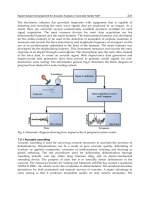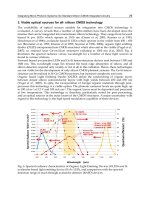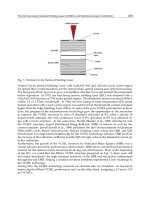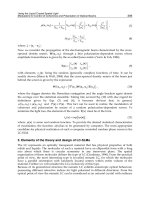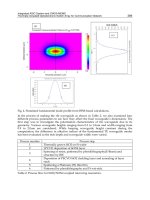Optoelectronics Materials and Techniques Part 9 potx
Bạn đang xem bản rút gọn của tài liệu. Xem và tải ngay bản đầy đủ của tài liệu tại đây (2.77 MB, 30 trang )
Optoelectronics - Materials and Techniques
230
Hu, D.; Lu, P.; Wang, C.; Liu, H.; Wang, H.; Wang, Z.; Fei, T.; Gu, X. & Ma, Y. (2009). Silane
coupling di-carbazoles with high triplet energy as host materials for highly efficient
blue phosphorescent devices. J. Mater. Chem., Vol.19, No.34, (August 2009) pp.6143-
6148, ISSN 0959-9428.
Imae, I. & Kawakami, Y. (2005). Unique photoluminescence property of a novel perfectly
carbazole-substituted POSS. J. Mater. Chem., Vol.15, No.43, (November 2005)
pp.4581-4583, ISSN 0959-9428.
Kawamura, Y.; Goushi, K.; Brooks, J.; Brown, J.; Sasabe, H. & Adachi, C. (2005). 100%
phosphorescence quantum efficiency of Ir(III) complexes in organic semiconductor
films. Appl. Phys. Lett., Vol.86, No.7, (February 2005) pp.071104 1-3, ISSN 0003-6951.
Kido, J.; Hongawa, K.; Okuyama, K. & Nagai, K. (1993). Bright blue electroluminescence
from poly(N-vinylcarbazole). Appl. Phys. Lett., Vol.63, No.19, (Novermber 1993)
pp.2627-2629, ISSN 0003-6951.
Kido, J.; Kimura, M. & Nagai, K. (May 1995). Multilayer white light-emitting organic
electroluminescent device. Science, Vol.267, No.5202, (1995) pp.1332-1334, ISSN
0036-8075.
Klăerner, G.; Davy, M. H. ; Chen, W. D.; Scott, J. C. & Miller, R. D. (1998). Colorfast Blue-
Light-Emitting Random Copolymers Derived from Di-n-hexylfluorene and
Anthracene. Adv. Mater., Vol.10, No.13, (September 1998) pp.993-997, ISSN 0935-
9648.
Klăerner, G.; Lee, J. I.; Davey, M. H. & Miller, R. D. (1999). Exciton Migration and Trapping
in Copolymers Based on Dialkylfluorenes. Adv. Mater., Vol.11, No.2, (February
1999) pp.115-119, ISSN 0935-9648.
Lamansky, S.; Djurovich, P.; Murphy, D.; Abdel-Razzaq, F.; Lee, H.; Adachi, C.; Burrows, P.;
Forrest, S. & Thompson, M. (2001). Highly Phosphorescent Bis-Cyclometalated
Iridium Complexes: Synthesis, Photophysical Characterization, and Use in Organic
Light Emitting Diodes. J. Am. Chem. Soc., Vol.123, No.18, (May 2001) pp.4304-4312,
ISSN 0002-7863.
Li, H.; Liu, C.; Guo, G.; Zhou, X.; Xie, P.; Yu, S. & Zhang, R. (2002). Self-assembling directed
synthesis of a novel terephthalamide-bridged ladderlike polysiloxane. J. Polym. Sci.
A: Polym. Chem., Vol.40, No.18, (September 2002) pp.3161-3170, ISSN 0887-624X.
Liao, L.; Pang, Y.; Ding, L. & Karasz, F. E. (2001). Blue-Emitting Soluble Poly(m-phenylene-
vinylene) Derivatives. Macromolecules, Vol.34, No.21, (September 2001) pp.7300-
7305, ISSN 0024-9297.
Liu, C.; Zhao, H.; Zhang, Y.; Xie, P. & Zhang, R. (2000). Synthesis and characterization of a
novel reactive ladderlike 4,4′-phenylene ether-bridged polyvinylsiloxane. J. Polym.
Sci. A: Polym. Chem., Vol.38, No.15, (August 2000) pp.2702-2710, ISSN 0887-624X.
Loy, D. A. & Shea, K. J. (1995). Bridged Polysilsesquioxanes. Highly Porous Hybrid Organic-
Inorganic Materials. Chem. Rev., Vol.95, No.5, (July 1995) pp.1431-1442, ISSN 0009-
2665.
Marsitzky, D.; Vestberg, R.; Blainey, P.; Tang, B. T.; Hawker, C. J. & Carter, K. R. (2001). Self-
Encapsulation of Poly-2,7-fluorenes in a Dendrimer Matrix. J. Am. Chem. Soc.,
Vol.123, No. 29, (July 2001) pp.6965-6972, ISSN 0002-7863.
Ladder Polysiloxanes for Optoelectronic Applications
231
Martin, R. E. & Diederich, F. (1999). Linear monodisperse п-conjugated oligomers: model
compounds for polymers and more. Angew. Chem., Int. Ed., Vol.38, No.10, (May
1999) pp.1351-1377, ISSN 1433-7851.
Műllen, K. & Wegner, G. (1999). Electronical Materials: The Oligomer Approach, Műllen, &
Wegner, K. G. Eds., Wiley-VCH, ISBN 3527294384, Weinheim, Germany.
Okoshi, K.; Sakajiri, K.; Kumaki, J. & Yashima, E. (2005). Well-Defined Lyotropic Liquid
Crystalline Properties of Rigid-Rod Helical Polyacetylenes. Macromolecules, Vol.38,
No.10, (May 2005) pp.4061-4064, ISSN 0024-9297.
Pogantsch, A.; Wenzl, F. P.; List, E. J. W.; Leising, G.; Grimsdale, A. C. & Műllen, K. K.
(2002). Polyfluorenes with Dendron Side Chains as the Active Materials for
Polymer Light-Emitting Devices. Adv. Mater., Vol.14, No.15, (August 2002) pp.1061-
1064, ISSN 0935-9648.
Ren, Z.; Cao, X.; Xie, P.; Zhang, R.; Yan, S. & Ma, Y. (2009). Supramolecular architecture-
directed synthesis of a reactive and purely inorganic ladder
polyhydrosilsesquioxane. Chem. Commun., Vol.45, No.27, (July 2009) pp.4079-4081,
ISSN 1359-7345.
Ren, Z.; Xie, P.; Jiang, S.; Yan, S. & Zhang, R. (2010). Study of the Supramolecular
Architecture-directed Synthesis of a Well-defined Triple-chain Ladder
Polyphenylsiloxane. Macromolecules, Vol.43, No.5, pp.2130-2136, ISSN 0024-9297.
Scherf, U. & Műllen, K. (1995). The Synthesis of Ladder Polymers, In: Adv. Polym. Sci., Abe,
A. et al., Vol. 123, pp.1-40, Springer Berlin, ISBN 978-3-540-58908-2, Heidelberg,
Germany.
Scherf, U. (1998). Conjugated Ladder-Type Structures, In: Handbook of Conducting Polymers,
Second Edition, Skotheim, T.; Elsenbaumer, R. L. & Reynolds, J. R., Chapter 14,
p.363, Marcel Dekker, ISBN 0824700503, New York, Basel, Hong Kong.
Scherf, U. (1999). Ladder-type materials. J. Mater. Chem., Vol.9, No.9, (September 1999)
pp.1853-1864, ISSN 0959-9428.
Segalman, R. A.; McCulloch, B.; Kirmayer, S. & Urban, J. J. (2009). Block Copolymers for
Organic Optoelectronics. Macromolecule, Vol.42, No.23, (December 2009) pp.9205-
9208, ISSN 0024-9297.
Service, R. F. (2005). Organic LEDs Look Forward to a Bright, White Future. Science, Vol.310,
No.5755, (December 2005) pp.1762-1763, ISSN 0036-8075.
Setayesh, S.; Grimsdale, A. C.; Weil, T.; Enkelmann, V.; Műllen, K.; Meghdadi, F.; List, E. J.
W. & Leising, G. (2001). Polyfluorenes with Polyphenylene Dendron Side Chains:
Toward Non-Aggregating, Light-Emitting Polymers. J. Am. Chem. Soc., Vol.123,
No.5, (February 2001) pp.946-953, ISSN 0002-7863.
Shea, K. J. & Loy, D. A. (2001). Bridged Polysilsesquioxanes. Molecular-Engineered Hybrid
Organic−Inorganic Materials. Chem. Mater., Vol.13, No.10, (October 2001) pp.3306-
3319, ISSN 0897-4756.
Shin, W. S.; Jeong, H. H.; Kim, M. K.; Jin, S. H.; Kim, M. R.; Lee, J. K.; Lee, J. W. & Gal, Y. S.
(2006). Effects of functional groups at perylene diimide derivatives on organic
photovoltaic device application. J. Mater. Chem., Vol.16, No.4, (January 2006)
pp.384–390, ISSN 0959-9428.
Optoelectronics - Materials and Techniques
232
Singh, M.; Chae, H. S.; Froehlich, J. D.; Kondou, T.; Li, S.; Mochizuki, A. & Jaabbour, G. E.
(2009). Electroluminescence from printed stellate polyhedral oligomeric
silsesquioxanes. Soft. Mater., Vol.5, No.16, (August 2009) pp.3002-3005, ISSN 1744-
683X.
Singh, M.; Haverinen, H. M.; Dhagat, P. & Jabbour, G. E. (2010). Inkjet Printing—Process
and Its Applications. Adv. Mater., Vol.22, No.6, (Febraury 2010) pp.673-685, ISSN
0935-9648.
Smith, P. F.; Gerrior, P.; Xie, S.; Hor, A. M. & Popovic, Z. (1998). Degradation of Organic
Electroluminescent Devices. Evidence for the Occurrence of Spherulitic
Crystallization in the Hole Transport Layer. Langmuir, Vol.14, No.20, (September
1998) pp.5946-5950.ISSN 0743-7463.
Son, S.; Dodabalapur, A.; Lovinger, A. J. & Galvin, M. E. (1995). Luminescence enhancement
by the introduction of disorder into poly(p-phenylene vinylene). Science, Vol.269,
No.5222, (March 1995) pp.376-378, ISSN 0036-8075.
Sun, J.; Jiang, J.; Zhang, Y.; Xie, P.; Tang, H. & Zhang, R. (2003). H-bonding assisted template
synthesis of a novel ladder-like organo-bridged polymethylsiloxane. Polymer,
Vol.44, No.10, (May 2003) pp.2867-2874, ISSN 0032-3861.
Sun, J.; Jiang, J.; Gao, X.; Tang, H.; Xie, P. & Zhang, R. (2003). Hydrogen-bonding-aided
synthesis of novel ladderlike organobridged polysiloxane containing side-chain
naphthyl groups. J. Polym. Sci. A: Polym. Chem., Vol.41, No.5, (March 2003) pp.636-
644, ISSN 0887-624X.
Tang, H.; Sun, J.; Jiang, J.; Zhou, X.; Hu, T.; Xie, P. & Zhang, R. B. (2002). A Novel Aryl
Amide-Bridged Ladderlike Polymethylsiloxane Synthesized by an Amido H-
Bonding Self-Assembled Template. J. Am. Chem. Soc., Vol.124, No.35, (September
2002) pp.10482-10488, ISSN 0002-7863.
Unno, M.; Suto, A.; Matsumoto, H. (2002). Pentacyclic Laddersiloxane. J. Am. Chem. Soc.,
Vol.124, No.8, (February 2004) pp.1574-1575, ISSN 0002-7863.
Vanhee, S.; Rulkens, R.; Lehmann, U.; Rosenauer, C.; Schulze, M.; Ko1hler, W. & Wegner, G.
(1996). Synthesis and Characterization of Rigid Rod Poly(p-phenylenes).
Macromolecules, Vol.29, No.15, (July 1996) pp.5136-5142, ISSN 0024-9297.
van Hutten, P. F. & Hadziioannou, G. (2000). Semiconducting polymers, van Hutten, P. F. &
Hadziioannou, G. Eds., pp. 561-613. Wiley-VCH, ISBN 9783527295074, Weinheim,
Germany.
Wan, Y.; Yang, L.; Zhang, J.; Zhang, P.; Fu, P.; Zhang, T.; Xie, P. & Zhang, R. (2006).
Template of Concerted CT and H-Bonding Interactions-Directed Synthesis of a
Highly Soluble and Perfect Organo-Bridged Ladder Polymethylsiloxane.
Macromolecules, Vol.39, No. 2, (January 2006) pp.541-549, ISSN 0024-9297.
Wang, Q.; Ding, J.; Zhang, B.; Mei, C.; Cheng, Y.; Xie, Z.; Wang, L.; Jing, X. & Wang, F.
(2009). Harvesting Excitons Via Two Parallel Channels for Efficient White Organic
LEDs with Nearly 100% Internal Quantum Efficiency: Fabrication and Emission-
Mechanism Analysis. Adv. Funct. Mater., Vol.19, No.1, (January 2009) pp.84-95,
ISSN 1616-301X.
Weinfurtner, K. H.; Fujikawa, H.; Tokito, S. & Taga, Y. (2000). Highly efficient pure blue
electroluminescence from polyfluorene: Influence of the molecular weight
Ladder Polysiloxanes for Optoelectronic Applications
233
distribution on the aggregation tendency. Appl. Phys. Lett., Vol.76, No.18, (May
2000) pp.2502-2504, ISSN 0003-6951.
Wu, W. C.; Yeh, H. C.; Chan, L. H. C. & Chen, T. (2002). Red Organic Light-Emitting Diodes
with a Non-doping Amorphous Red Emitter. Adv. Mater., Vol.14, No.15, (August
2002) pp.1072-1075, ISSN 0935-9648.
Wu, Z.; Xiong, Y.; Zou, J.; Wang, L.; Liu, J.; Chen, Q.; Yang, W.; Peng, J. & Cao, Y. (2008).
High-Triplet-Energy Poly(9,9′-bis(2-ethylhexyl)-3,6-fluorene) as Host for Blue and
Green Phosphorescent Complexes. Adv. Mater., Vol.20, No.12, (June 2008) pp.2359-
2364, ISSN 0935-9648.
Xiao, L.; Chen, Z., Qu, B.; Luo, J.; Kong, S.; Gong, Q. & Kido, J. (2010). Rencent Progresses on
Materials for Electrophosphorescent Organic Light-Emitting Devices. Adv. Mater.,
Vol.23, No.8,(February 2011) pp.926-952, ISSN 0935-9648.
Xiao, S.; Nguyen, M.; Gong, X.; Cao, Y.; Wu, H.; Moses, D. & Heeger, A. J. (2003).
Stabilization of Semiconducting Polymers with Silsesquioxane. Adv. Funct. Mater.,
Vol.13, No.1, (January 2003) pp.25-29, ISSN 1616-301X.
Yamamoto, S.; Yasuda, N.; Ueyama, A.; Adachi, H. & Ishikawa, M. (2004). Mechanism for
the Formation of Poly(phenylsilsesquioxane). Macromolecules, Vol.37, No.8, (April
2004) pp.2775 –2778, ISSN 0024-9297.
Yang, X.; Froehlich, J. D.; Chae, H. S.; Li, S.; Mochizuki, A. & Jaabbour, G. E. (2009). Efficient
Light-Emitting Devices Based on Phosphorescent Polyhedral Oligomeric
Silsesquioxane Materials. Adv. Funct. Mater., Vol.19, No.16, (August 2009) pp.2623-
2629, ISSN 1616-301X.
Yang, X.; Froehlich, J. D.; Chae, H. S.; Harding, B. T.; Li, S.; Mochizuki, A. & Jabbour, G. E.
(2010). Efficient Light-Emitting Devices Based on Platinum-Complexes-Anchored
Polyhedral Oligomeric Silsesquioxane Materials. Chem. Mater., Vol.22, No.16,
(August 2010) pp.4776-4782, ISSN 0897-4756.
Yu, W. L.; Cao, Y.; Pei, J.; Huang, W. & Heeger, A. J. (1999). Blue polymer light-emitting
diodes from poly(9,9-dihexylfluorene-alt-co-2, 5-didecyloxy-para-phenylene). Appl.
Phys. Lett., Vol.75, No.21, (November 1999) pp.3270-3272, ISSN 0003-6951.
Zhang, J.; Chen, Z.; Fu, W.; Xie, P.; Li, Z.; Yan, S. & Zhang, R. (2010). Supramolecular
Template-Directed Synthesis of Stable and High-Efficiency Photoluminescence 9,
10-Diphenylanthryl-Bridged Ladder Polysiloxane. J, Polym. Sci., A: Polym. Chem.,
Vol.48, No.11, (May 2010) pp.2491-2497, ISSN 0887-624X.
Zhang, R. B.; Dai, D. R.; Cui, L.; Xu, H.; Liu, C. Q. & Xie, P. (1999). A glance at the relation of
stepwise coupling polymerization to supramolecular chemistry. Mater. Sci. Eng.
Vol.C10, No.1-2, (December 1999) pp.13-18, ISSN 0928-4931.
Zhang, T.; Deng, K.; Zhang, P.; Xie, P. & Zhang, R. B. (2006). Supramolecular Template-
Directed Synthesis of Perfect Phenelenediimino-Bridged Ladderlike
Polyphenylsiloxanes. Chem. Eur. J., Vol.12, No.13, (April 2006) pp.3630-3635, ISSN
0947-6539.
Zhang, X.; Xie, P.; Shen, Z.; Jiang, J.; Zhu, C.; Li, H.; Zhang, T.; Han, C. C.; Wan, L.; Yan, S. K.
& Zhang, R. B. (2006). Confined Synthesis of a cis-Isotactic Ladder
Polysilsesquioxane by Using a p-Stacking and H-Bonding Superstructure. Angew.
Chem., Int. Ed., Vol.45, No.19, (May 2006) pp.3112-3116, ISSN 1433-7851.
Optoelectronics - Materials and Techniques
234
Zhang, Z. X.; Hao, J.; Xie, P.; Zhang, X.; Han, C. C. & Zhang, R. B. (2008). A Well-Defined
Ladder Polyphenylsilsesquioxane (Ph-LPSQ) Synthesized via a New Three-Step
Approach: Monomer Self-Organization-Lyophilization—Surface-Confined
Polycondensation. Chem. Mater., Vol.20, No.4, (February 2008) pp.1322-1330, ISSN
0897-4756.
Zhou, Q.; Yan, S.; Han, C. C.; Xie, P. & Zhang, R. (2008). Promising Functional Materials
Based on Ladder Polysiloxanes. Adv. Mater., Vol.20, No.15, (August 2008) pp.2970-
2976, ISSN 0935-9648.
Zhou, Q.; Zhang, J.; Ren, Z.; Yan, S.; Xie, P. & Zhang, R. (2008). A Stable and High-Efficiency
Blue-Light Emitting Terphenyl-Bridged Ladder Polysiloxane. Macromol. Rapid.
Commun., Vol.29, No.14, (July 2008) pp.1259-1263, ISSN 1022-1336.
9
Synthesis of Aromatic-Ring-Layered Polymers
Yasuhiro Morisaki and Yoshiki Chujo
Kyoto University,
Japan
1. Introduction
In the fields of polymer and material chemistry, conjugated polymers (Skotheim et al., 2006)
are an important class of polymers for next-generation optoelectronic materials due to their
intriguing conductivity, photoluminescence, electroluminescence, and liquid crystallinity.
Numerous conjugated polymers have been synthesized thus far, and a variety of unique
conjugation systems have been incorporated into conjugated polymer backbones. One of the
current research topics in this field focuses on the construction of layered and/or π-stacked
structures. Layered π-electron systems are commonly found in both nature and artificial
materials; for example, light-harvesting antenna complexes in photosynthetic systems, such
as chlorophylls and bacteriochlorophylls, consist of layered π-electron systems. In
optoelectronic materials, charges are delocalized in some layers and transferred from one
electrode to the opposite one through the layered π-electron systems. Despite the
importance of the layered structures of the π-electron systems, the synthesis of polymers
comprising layered-aromatic rings and π-electron systems in a single polymer chain has
rarely been studied (Morisaki & Chujo, 2006; Morisaki & Chujo, 2008a; Morisaki & Chujo,
2009d; Nakano, 2010).
To achieve the construction of the desired layered structure, xanthene, anthracene, and
naphthalene compounds can be employed as scaffolds. The rotary motion of two aromatic
units substituted at the 4,5-positions of xanthene, 1,8-positions of anthracene, and 1,8-
positions of naphthalene is restricted due to steric hindrance, leading to a face-to-face
structure. Thus, this review presents a summary of the syntheses and properties of a new
class of aromatic ring-layered polymers, as well as oligomers containing xanthene,
anthracene, and naphthalene scaffolds. Due to the vast number of studies on xanthene-,
anthracene-, and naphthalene-based face-to-face dimeric systems, the polymers and
oligomers (i.e., three or more face-to-face aromatic rings) are drawn.
2. Xanthene-based polymers
The 4,5-positions of xanthene can be readily functionalized by the treatment of xanthene
compounds with alkyllithium reagents to yield the corresponding 4,5-dilithiated xanthenes
due to the lithium-oxygen interaction, as shown in Scheme 1 (Morisaki & Chujo, 2005). The
reaction of the 4,5-dilithiated xanthenes with halogens such as iodine results in the
formation of diiodoxanthene derivative 1, which is used in the palladium-catalyzed
coupling reactions.
Optoelectronics - Materials and Techniques
236
Scheme 1. Synthesis of monomer 1
Scheme 2. Synthesis of polymers P1-P3
entry Mono-ethylarene
Feed ratio
x : y : z
Polymer Yield (%)
M
n
(calcd.)
M
n
(found by
1
H NMR)
1 10 : 9 : 2
P1a
79 5956 4100
2 5 : 4 : 2
P1b
65 3082 3100
3
3 : 2 : 1
P1c
50 1933 2100
4 10 : 9 : 2
P2a
70 5896 7500
5 5 : 4 : 2
P2b
50 3022 4200
6
3 : 2 : 1
P2c
65 1872 2600
7 10 : 9 : 2
P3a
76 5786 5750
8 5 : 4 : 2
P3b
59 2912 3000
9
3 : 2 : 1
P3c
56 1762 1700
Table 1. Polymerization results
As shown in Scheme 2, the Sonogashira-Hagihara coupling (Tohda et al., 1975; Sonogashira,
2002) of diiodoxanthene 1 with either a diethynylarene, such as pseudo-p-
diethynyl[2.2]paracyclophane 2, or mono-ethynylarenes 3–5 proceeded smoothly to produce
[2.2]paracyclophane-layered polymers (Morisaki et al., 2008b; Morisaki et al., 2009b). The
results are summarized in Table 1. In the presence of mono-ethynylarenes 3–5, aromatic
groups were introduced as end-capping units. Polymers P1, P2, and P3 possess
[2.2]paracyclophane, anthracene, and nitrobenzene as the end-capping units, respectively.
Their molecular weights were controlled by the molar ratios of the monomers, as shown in
Table 1. For example, in the case of a molar ratio (x:y:z) of 9:10:2, the number average
molecular weights (M
n
) of P1a, P2a, and P3a were 4100, 7500, and 5750 (entries 1, 4, and 7),
respectively, which were calculated from their respective
1
H NMR spectra.
Synthesis of Aromatic-Ring-Layered Polymers
237
Fig. 1. UV-vis absorption (UV) spectra of polymers P1a-c in CHCl
3
(1.0 × 10
–5
M).
Fig. 2. (A) UV-vis absorption spectra in CHCl
3
(1.0 × 10
–5
M) and photoluminescence (PL)
spectra in CHCl
3
(5.0 ×10
–7
M) of P1a. (B) UV-vis absorption spectra in CHCl
3
(1.0 × 10
–5
M)
and PL spectra in CHCl
3
(5.0 × 10
–7
M) of P2b.
As shown in the UV-vis absorption spectra (in CHCl
3
, 1.0 × 10
–5
M) of polymers P1a–c
(Figure 1), there were π–π* absorption bands at around 290 and 330 nm. The absorption
spectra of P1a–c were independent of the number of the layered [2.2]paracyclophanes. It is
reported that neighboring [2.2]paracyclophane units in the polymer backbone have
sufficient free space according to X-ray crystallographic analysis of the model compound
(Morisaki et al., 2009a). Therefore, π-π interactions among [2.2]paracyclophane units in a
single polymer chain are considered to be weak in the ground state.
The optical properties of polymers P1a (M
n
= 4100) and P2b (M
n
= 4200) were compared.
Figures 2A and 2B show the UV-vis absorption and emission spectra of polymers P1a and
P2, respectively. As shown in Figure 2A (see also Figure 1), the π–π* band of the layered
[2.2]paracyclophane units was observed in the spectrum of P1a, whereas a sharp absorption
peak at around 270 nm and a broad absorption peak at around 400 nm appeared in the
Optoelectronics - Materials and Techniques
238
spectrum of P2b (Figure 2B). These new absorption bands were derived from the anthracene
units at the polymer P2b chain ends.
Polymer P1a emitted blue light with a peak at around 400 nm after excitation at 334 nm
(Figure 2A), which was attributed to emission from the layered [2.2]paracyclophane
moieties. P2b exhibited a quite different photoluminescence spectrum with a peak at around
450 nm with a vibrational structure on the excitation wavelength of 334 nm (Figure 2B). This
excitation wavelength excited only the layered [2.2]paracyclophane moieties because the
end-capping anthracene units do not have an absorption band around 334 nm. Thus, P2b
emitted from the terminal anthracenes instead of emitting from the layered
[2.2]paracyclophanes. As shown in Figures 2A and 2B, the emission peak of the layered
cyclophane units (at 400 nm in Figure 2A) efficiently overlapped with the absorption band
of the anthracene moieties (at around 400 nm in Figure 2B). Time-resolved
photoluminescence spectra of P2b are shown in Figure 3; these spectra indicate that
emission from the cyclophane units decreased while that from the anthracene units
increased. These results suggest that fluorescence resonance energy transfer (FRET) (Förster,
1946) from the cyclophane units to the end-capping anthracenes occurs.
Fig. 3. Time-resolved PL spectra of polymer P2b in CHCl
3
.
The UV-vis absorption spectra of the nitrobenzene-end-capped polymers P3a–c (in CHCl
3
,
1.0 × 10
–5
M) are shown in Figure 4A. These spectra exhibited broad absorption bands
around 400 nm in addition to the π–π* transition band of the layered [2.2]paracyclophanes;
the absorbance around 400 nm increased as the M
n
value decreased. This absorption band
arises from the polymer chain ends that contain nitrophenyl groups as the concentration of
the end-capping nitrophenyl groups increased with a decreasing M
n
value. As can be
expected, the emission from the [2.2]paracyclophane moieties was quenched by the
introduction of the nitrophenyl units at the polymer chain ends due to the good overlap
between the emission peak of the [2.2]paracyclophane moieties and the absorption band of
the nitrophenyl moieties. As shown in Figure 4B, the photoluminescence peak intensities
and the photoluminescence quantum efficiencies of P3a–c decreased relative to those of P1a.
The end-capping nitrophenyl groups of P3a–c effectively quenched the photoluminescence
from the layered [2.2]paracyclophane moieties by FRET. It is reported that the end-capping
nitrophenyl group quenched photoluminescence 1.0 × 10
4
times more effectively than the
addition of nitrobenzene to a P1a solution.
Synthesis of Aromatic-Ring-Layered Polymers
239
Fig. 4. (A) UV spectra in CHCl
3
(1.0 × 10
–5
M) and photoluminescence (PL) spectra in CHCl
3
(5.0 × 10
–7
M) of polymers P3a-c. (B) UV spectra in CHCl
3
(1.0 × 10
–5
M) and PL spectra in
CHCl
3
(5.0 × 10
–7
M) of polymers P1a and P3a-c.
This synthetic approach using xanthene as the scaffold makes it possible to incorporate
various aromatic compounds as the layered ring units in a single polymer chain. Scheme 3
shows the synthesis of 4,5-diethynylxanthene 3 as well as its polymerization with
diiodocarbazoles 4 and 5. The results of polymerization are summarized in Table 2.
Polymers P4 (Fernandes et al., 2010) and P5 (Morisaki et al., 2009e) comprise 2,7-substituted
and 3,6-substituted carbazoles, and their M
n
values were calculated to be 2500 and 2300
(Table 2), respectively.
Scheme 3. Synthesis of monomer 3 and polymers P4 and P5.
Optoelectronics - Materials and Techniques
240
entry Polymer Yield (%) M
n
M
w
/M
n
1
P4
63 2500 1.3
2
P5
62 2300 1.1
Table 2. Synthesis of polymers P4 and P5
M
n
and M
w
/M
n
were calculated by MALDI-TOF mass spectra and GPC (CHCl
3
, polystyrene
standards), respectively.
Fig. 5. UV spectra in CHCl
3
(1.0 × 10
–5
M) and PL spectra in CHCl
3
(1.0 × 10
–7
M) of
polymers P4 and P5.
The UV-vis absorption and photoluminescence spectra of P4 and P5 in diluted CHCl
3
solution
are shown in Figure 5. The conjugation length of P4, which consists of 2,7-linked carbazole
units, was longer than that of P5, which has 3,6-linked carbazole units. π-Conjugation of the
3,6-linked carbazole unit is not effective because the 3,6-linked carbazole unit on xanthene is
twisted due to steric hindrance, which results in the shorter wavelength of the absorption peak
in P5 as compared to that of P4. In Figure 5, P4 and P5 are shown to exhibit emission peak
maxima at 431 and 425 nm, respectively. The Stokes shift of P5 was greater than that of P4
suggesting that the conformation change from the ground state to the excited state of the 3,6-
linked carbazole is larger than that of 2,7-linked carbazole due to the boomerang shape of the
3,6-linked carbazole unit (Morin et al., 2005; Grazulevicius et al., 2003).
The fluorescence emission spectrum of N-(p-tolyl)carbazole-layered polymer P6 with
nitrophenyl groups at the polymer chain ends was investigated to show its potential as a
single molecular wire in comparison with P7. Figure 6A shows the photoluminescence spectra
of polymers P6 and P7 in CHCl
3
. The peak intensity of P6 clearly decreased and the
photoluminescence quantum yield (
Φ
PL
) of P6 was estimated to be 1% indicating that the
terminal nitrophenyl moieties in P6 quenched the emission from the layered carbazole units.
To compare, 1, 10, and 100 equivalents of nitrobenzene molecules per carbazole unit were
added as a fluorescence quencher to a solution of P7, as shown in Figure 6B. However,
ineffective quenching of the emission from the layered carbazole in P7 was observed. The
carbazole-layered polymer can also act as a molecular wire that transfers energy and/or
electrons to the polymer termini in the same manner as the cyclophane-layered polymers
discussed above.
Synthesis of Aromatic-Ring-Layered Polymers
241
Fig. 6. (A) UV spectra of polymers P6 and P7 in CHCl
3
(1.0 × 10
–5
M). (B) PL spectra of
polymer P7 with nitrobenzene in CHCl
3
(1.0 × 10
–7
M).
By using xanthene as the scaffold, not only aromatic compounds but also π-conjugated
oligomers can be one-dimensionally layered in a single polymer chain. Scheme 4 outlines
the synthetic procedure of the oligo(p-pheneylene)-layered polymers (Morisaki et al., 2009c)
by modified Suzuki-Miyaura coupling (Miyaura et al., 1979; Miyaura & Suzuki, 1995). In
this case, tert-butyl groups were not introduced into the xanthene skeleton because of their
steric bulk and dodecyl groups were substituted at the 9-position of xanthene in order to
improve the solubility of the polymers. The reaction of monomers 6 and 7 (10:9) was carried
out in the presence of Pd(OAc)
2
with 2-dicyclohexylphosphino-2',6'-dimethoxybiphenyl (S-
Phos) as the ligand (Scheme 4) (Barder et al., 2005), and the successive addition of p-
methoxyphenyl boronic acid 8 and p-nitorophenyl boronic acid 9 afforded the
corresponding polymers P8 and P9 in 37% and 40% isolated yields with M
n
values of 6100
and 6250, respectively.
Optoelectronics - Materials and Techniques
242
Scheme 4. Synthesis of polymers P8 and P9.
Figure 7A shows the photoluminescence spectra of P8 and P9 in diluted CHCl
3
solutions;
the spectra are almost identical and feature peak maxima at around 410 nm. As can be
expected, the peak intensity of P9 (
Φ
PL
= 55%) was lower than that of P8 (
Φ
PL
= 25%),
indicating that the end-capping nitrobenzene units of P9 quench the emission from the
layered biphenylenes. The photoluminescence spectra of P8, which possesses p-
methoxyphenyl chain ends, with an excess amount of nitrobenzene are shown in Figure 7B.
However, the quenching effect of the additional nitrobenzene was quite low despite the
addition of 100 equivalents of nitrobenzene per biphenylene unit. According to the Stern–
Volmer plots, the Stern–Volmer coefficient (K
sv
) of P9 was 10
4
times larger than that of P8
upon the addition of nitrobenzene. The two end-capping nitrophenyl moieties in P9
effectively quenched the photoluminescence from the layered biphenylenes via through-
space interactions of the single polymer chain.
Fig. 7. (A) UV spectra of polymers P8 and P9 in CHCl
3
(1.0 × 10
–5
M). (B) PL spectra of
polymer P8 with 100 equiv of nitrobenzene in CHCl
3
(1.0 × 10
–7
M).
Synthesis of Aromatic-Ring-Layered Polymers
243
Oligothiophenes were also layered on xanthenes (Morisaki et al., 2009f; Morisaki et al.,
2010b); the synthetic routes for the bithiophene-layered polymer P10 by iron-mediated
oxidative coupling and modified Suzuki-Miyaura coupling are shown in Scheme 5.
Bis(thienyl)xanthene monomer 10 was prepared in 81% yield by Negishi coupling (Negishi
et al., 1977; Negishi, 1982) of 2-thienylzinc bromide and 6 and then treated with FeCl
3
to
obtain the corresponding polymer P10 in 84% isolated yield with an M
n
of 4500. However,
P10 was contaminated with a small amount of iron species. Therefore, an alternate synthesis
was pursued; compound 10 was readily iodinated to afford monomer 11 in 56% yield,
which was reacted with bis(pinacolato)diboron 12 in the presence of a catalytic amount of
Pd(OAc)
2
/S-Phos to give P10 in 25% isolated yield with an M
n
of 2600.
The UV-vis absorption spectra of P10 and model compound 13 in CHCl
3
solutions are
shown in Figure 8. The absorption maximum of P10 was observed at around 360 nm, while
that of 13 appeared at 379 nm due to the contribution of the coplanarity of the bisthiophene
and the methoxyphenyl groups of 11 in the ground state (Figure 9). This was supported by
the
1
H NMR spectrum of 13. The bithiophene units in P10 rotate freely to avoid steric
hindrance, while the bithiophene units in 13 adopt a relatively planar structure to extend its
conjugation length (Figure 9).
Scheme 5. Synthesis of polymer P10.
Fig. 8. UV spectra of polymer P10 and compound 13 in CHCl
3
(1.0 × 10
–5
M).
Optoelectronics - Materials and Techniques
244
Fig. 9. Structures of polymer P10 and compound 13.
Terthiophene-, quarterthiophene- and quinquethiophene-layered polymers were
synthesized by the coupling reaction of 11 with monomers 14–16, as shown in Scheme 6; the
polymerization results are listed in Table 3. The isolated yields of P10–13 were relatively low
(19%–40%) due to repeated reprecipitation and purification using recyclable liquid
chromatography. The polymers obtained were soluble in common organic solvents such as
THF, CH
2
Cl
2
, CHCl
3
, and toluene. The polymer thin films were readily formed by spin-
coating from their toluene solution. The thermal stabilities of the polymers were examined
by thermogravimetric analysis (TGA) and all polymers were sufficiently stable with a 10%
weight loss at temperatures around 400 °C under N
2
(Figure 10).
Scheme 6. Synthesis of polymers P11-P13.
The UV-vis absorption spectra and PL spectra of P10–P13 in CHCl
3
are shown in Figure 11;
the data are listed in Table 3. In Figure 11A, absorption bands assigned to the π–π* transition
of oligothiphenes were observed, and the absorption maxima bathochromically shifted as
the number of thiophene rings increased.
Synthesis of Aromatic-Ring-Layered Polymers
245
entry Polymer Yield (%) M
n
M
w
/M
n
λ
abs,max
(nm)
λ
PL,max
(nm)
Φ
PL
1
P10
25 2600 1.1 360 440, 470 0.12
2
P11
40 3200 1.0 358, 380(sh) 480, 504 0.20
3
P12
30 2800 1.1
412 520(sh),
541
0.29
4
P13
19 3800 1.1 420 534, 562 0.27
Table 3. Polymerization results and optical properties
M
n
and M
w
/M
n
were calculated by MALDI-TOF mass spectra and GPC (CHCl
3
, polystyrene
standards), respectively.
λ
abs,max
was measured in CHCl
3
(1.0 x 10
–5
M).
λ
PL,max
was measured
in CHCl
3
(1.0 x 10
–7
M) excited at each absorption maximum.
Φ
PL
was absolute quantum
efficiency in solution.
Fig. 10. TGA thermograms of polymers P10-13.
Fig. 11. (A) UV spectra of polymers P10-13 in CHCl
3
(1.0 × 10
–5
M). (B) PL spectra of
polymers P10-13 in CHCl
3
(1.0 × 10
–7
M).
Optoelectronics - Materials and Techniques
246
Figure 11B exhibits the photoluminescence spectra of P10–P13 by excitation at each
absorption maximum. The red-shift of the spectra was observed with an increase in the
number of the thiophene rings in the same manner as in common conjugated systems. The
photoluminescence absolute quantum efficiencies (
Φ
PL
) in CHCl
3
solutions were estimated
to be 0.12–0.29, as listed in Table 3. Generally, the
Φ
PL
values of the π-stacked bisthiophenes
were low (0.001–0.054) because of the intermolecular aggregation of bisthiophenes due to
strong π-π interactions. The layered oligothiophenes are considered to be isolated in a single
polymer chain due to the relatively long distance between the 4- and 5-positions of the
xanthene skeleton despite the layered structure of P10–P13.
Cyclic voltammetric (CV) analyses of P10–P13 were carried out in CH
2
Cl
2
, and the resultant
cyclic voltammograms are shown in Figure 12. Broad oxidation peaks were observed
ranging from 0.4 to 0.5 V with a ferrocene/ferrocenium (Fc/Fc
+
) external reference, as
shown in Figure 12. The onset potentials of P10–P13 were found to be approximately 0.15 V
(vs. Fc/Fc
+
); they decreased slightly as the number of thiophene rings increased. The
HOMO energy levels of the polymers were calculated to be approximately –5.0 eV,
suggesting that the oligothiophene-layered polymers have potential for applications in
optoelectronic devices as hole-transporting materials.
Fig. 12. Cyclic voltammograms of polymers P10-13 in CH
2
Cl
2
(vs. ferrocene/ferrocenium).
Furan can also be incorporated as the layered-aromatic unit into the oligothiophene-layered
polymers (Fernandes et al., 2011). As shown in Scheme 7, the treatment of 11 with 2,5-
bis(tributylstannyl)furan 17 in the presence of Pd(PPh
3
)
4
/CuO afforded the corresponding
polymer P14, which contains a thiophene/furan/thiophene oligomer as the layered unit.
Migita-Kosugi-Stille coupling (Kosugi et al., 1977; Milstein & Stille, 1978) of 4,5-
bis(bromofuryl)xanthene 19 and 2,5-bis(tributylstannyl)thiophene 20 yielded polymer P15,
which contains a furan/thiophene/furan oligomer as the layered unit (Scheme 7). The M
n
values of P14 and P15 were 3700 and 4000, respectively.
Synthesis of Aromatic-Ring-Layered Polymers
247
Scheme 7. Synthesis of polymers P14 and P15.
In the UV-vis absorption spectra (1.0 × 10
–5
M in THF) of P14 and P15 (Figure 13), the
absorption maximum of P14, which was ascribed to the π–π* transition band of the
thiophene/furan/thiophene moieties, was observed at 344 nm, while the absorption
maximum of P15, consisting of furan/thiophene/furan units, appeared at 396 nm. It is
reported that the absorption spectra were almost identical regardless of the thiophene/furan
sequence. In addition, in the case of furan- and thiophene-substituted porphyrin systems, a
longer π-conjugation length between the porphyrin ring and meso-substituted-furan was
observed than between the porphyrin ring and meso-substituted-thiophene due to steric
repulsion. Therefore, it is implied that the thiophene/furan/thiophene moiety in P14 is
more twisted against the xanthene scaffold than the furan/thiophene/furan moiety in P15
in the ground state.
Fig. 13. UV spectra in CHCl
3
(1.0 × 10
–5
M) and PL spectra in CHCl
3
(1.0 × 10
–7
M) of
polymers P14 and P15.
Optoelectronics - Materials and Techniques
248
The photoluminescence spectra of P14 and P15 (1.0 × 10
–7
M in THF) are shown in Figure 13.
Both polymers exhibited similar photoluminescence spectra with the peak around 480 nm
and photoluminescence quantum efficiencies of 0.25. The conformational change of P14
from the twisted structure to the coplanar structure by photo-excitation resulted in a larger
Stokes shift for P14 than for P15. It is possible that the interactions among the layered π-
electron systems in a single polymer chain are weak because of the relatively long distance
between the 4- and 5-postions of the xanthene skeleton as well as because of the coplanarity
of the layered π-electron system with xanthene in the excited state.
Fig. 14. Redox behavior of compound 21.
Although it is not a polymer, xanthene-based compound 21, which consists of layered
quaterthiophenes, was synthesized (Takita et al., 2008), as shown in Figure 14. By chemical
oxidation with Et
3
O·SbCl
6
or electrical oxidation, one quarterthiophene was oxidized to
form a π-dimer (mixed-valence compound). This class of polymer can potentially be applied
to molecular actuation responding to the redox of quaterthiophenes (Figure 14).
Oligothiophene-layered polymers based on calix[4]arene also exhibit similar redox
behaviors (Yu et al., 2003; Yu et al., 2004; Casanovas et al., 2006; Alemán et al., 2006; Scherlis
& Marzari, 2005; Song & Swager, 2008), suggesting that they are candidates for sensing and
actuating materials as well.
3. Xanthene-based oligomers
Perilenediimide and its derivatives have been focused on as the active materials for light-
harvesting system photovoltaics and charge/electron transfer processes. In order to obtain
insight into the nature of the photophysical properties of perilenediimide aggregates, they
were layered onto the xanthene scaffold. As shown in Figure 15, reference compound 22 as
well as oligomers 23a–b, and 24, which contain two and three cofacial perilenediimides,
respectively, were prepared (Giaimo et al., 2008; Yoo et al., 2010). Their photophysical data
are listed in Table 4. The absorption maxima of 23a–b and 24 were shifted hypsochromically
in comparison with that of 22 due to the formation of H-like aggregates. The
photoluminescence spectrum of 22 exhibited a sharp spectrum with an emission maximum
at 534 nm and vibronic structures at 576 nm and 624 nm. In contrast, the photoluminescence
spectra of 23a–b and 24 were broad and featureless; the spectrum of 23a was highly broad
with a peak at around 700 nm, and that of 23b had a shoulder peak at around 550 nm and a
broad peak at 650 nm. Time-resolved absorption and photoluminescence spectroscopy
indicated that 23b having 12-tricosanyl substituents exhibited slower formation of the
Synthesis of Aromatic-Ring-Layered Polymers
249
excimer-like excited state and had a higher energy than 23a, which has n-octyl substituents,
because of its more bulky substituents. These results imply that perilenediimide
chromophores in 23a adopt nearly optimal π-stacking. Their photophysical properties in the
polymer matrix were also studied (Yoo et al, 2010). It was observed that the
photoluminescence intensity and lifetime depended on the molecular conformations in the
polymer matrix. Intramolecular overlap of the π-electron systems in perilenediimides would
favor the use of n-type semiconductors.
Fig. 15. Structures of compounds 22-24.
entry Compound
λ
abs,max
/ nm
λ
em,max
/ nm
Φ
PL
τ
PL
/ ns (
λ
em
)
1
22
527 533 0.98 3.8±0.1 (550)
2
23a
490 735 0.02 9.2±0.1 (700)
3
23b
491 647 0.19
0.05±0.01 (550)
28.6±0.1 (700)
4
24
488 647 0.13
0.05±0.01 (550)
22.5±0.1 (700)
Table 4. Photophysical Data of Compounds 22-24
Photoluminescence spectra, quantum efficiencies (
Φ
PL
), and lifetimes (
τ
PL
) were determined
with an excitation wavelength of 400 nm.
Fig. 16. Structures of oligomers 25-27.
Optoelectronics - Materials and Techniques
250
π-Stacked oligomers 25–27 comprising anthracene as the layered unit and xanthene as the
scaffold were synthesized (Morisaki et al., 2010a) by repeated Sonogashira-Hagihara couplings
(Figure 16). An anthracene-stacked polymer, P16, was also prepared by the reaction of 6 with
28 and 29 in 59% yield with an M
n
of 4600, as shown in Scheme 8. According to the
1
H NMR
spectra of oligomers 25–27 and polymer P16, the chemical shifts of the anthracene protons
moved to a higher magnetic field than those of the common anthracene derivatives. Their
signals gradually shifted as the number of stacked anthracene moieties increased because of
the effect of the ring current of the neighboring anthracene rings.
Scheme 8. Synthesis of polymer P16.
Fig. 17. (A) UV spectra of oligomers 25-27 and polymer P16 in CHCl
3
(1.0 × 10
–5
M). (B) PL
spectra of oligomers 25-27 and polymer P16 in CHCl
3
(1.0 × 10
–7
M).
As shown in Figure 17A, the molar extinction coefficient (
ε
) of an absorption and a broad
band at around 250 nm and 400 nm, respectively, increased in accordance with the number
of anthracene rings. The photoluminescence spectrum of 25 in CHCl
3
revealed an emission
peak at around 450 nm with a clear vibrational structure (Figure 17B); excimer-like emission
did not appear despite the face-to-face orientation of the two anthracenes in 25. In contrast,
the photoluminescence spectra of 26, 27, and P16 were broad without any vibrational
structure. A fluorescence life time measurement of P16 indicated emission from the excimer-
like structures of the anthracene moieties, whereas oligomers 26, 27, and polymer P16
exhibited emission mainly from aggregates because of the buttressing effect of the
anthracene rings. These phenomena are attributed to the intramolecular π-stacked structure
of the anthracene rings in both the excited and ground states.
Synthesis of Aromatic-Ring-Layered Polymers
251
4. Anthracene-based oligomers and polymers
Anthracene can be employed as the scaffold to layer aromatic rings one-dimensionally.
Aromatic rings at the 1- and 8-positions of anthracene readily face each other due to the
presence of hydrogen at the 9-position. Face-to-face porphyrin arrays, 32, were constructed
by condensation of formyl- and porphyrin-substituted anthracene, 30, with dipyrromethane
31 followed by oxidation (Scheme 9) (Nagata et al., 1990). In addition, oligomer 33
comprising five-layered porphyrin was prepared from dimeric porphyrin (Scheme 9).
Scheme 9. Synthesis of oligomer 32 and structure of oligomer 33.
According to the absorption spectra of 32–35 in 1,2-dichlorobenzene solutions, the Soret
bands of the zinc complexes of 32 and 33 (face-to-face systems) were hypsochromically
shifted, without being split, as the number of layered porphyrins increased. In contrast,
those of 34 and 35 (linear systems, Figure 18) bathochromically shifted with a split that
became larger with an increasing number of porphyrins. These results can be explained by
the exciton coupling theory.
Fig. 18. Structures of linear oligomers 34 and 35.
A 1,8-anthracene-linked Fe(III)-porphyrin trimer, 36, (Figure 19) was synthesized (Naruta et
al., 1994); the Fe(III) ions were connected by imidazolates. According to electron
paramagnetic resonance (ESR) and magnetic susceptibility measurements, the anti-
ferromagnetic exchange coupling (–J) was calculated to be 15.3 cm
–1
. Without the imidazole
moieties, no magnetic interaction among the Fe(III) ions was observed. The appropriate
Optoelectronics - Materials and Techniques
252
distance and the face-to-face arrangement of the Fe(III) ions resulted in a short distance of
~2.0 Å between the Fe(III) ion and nitrogen atom of imidazolate leading to the anti-
ferromagnetic exchange coupling among the Fe(III) ions.
Fig. 19. Structure of oligomer 36.
A benzene ring-layered polymer, P17, was synthesized via Suzuki-Miyaura
polycondensation between 1,8-bis(trifluoromethyl)anthracene 37 and p-phenylene
diboronate 38, as shown in Scheme 10 (Sangvikar et al., 2009). Additionally, cyclic dimers
were also isolated in 5% yield. The M
n
of P17 was relatively high (M
n
= 7000, M
w
/M
n
= 2.0),
which suggests the possibility of obtaining this class of polymers with a longer chain length.
Scheme 10. Synthesis of polymer P17
5. Naphthalene-based oligomers and polymers
The distance between the 1- and 8-carbon atoms of naphthalene compounds is
approximately 2.5–2.6 Å; therefore, aromatic groups substituted at the 1,8-positions of
naphthalene derivatives are constrained in a face-to-face arrangement. Various 1,8-
diarylnaphthalenes have been synthesized, and their π-stacked structures and π-π
interactions have been studied. However, oligomers and polymers composed of multi-
stacked aromatic rings have rarely been developed.
π-Stacked metallocene polymers were obtained, as shown in Scheme 11. The treatment of
1,8-diiodonaphthalene 39 with 1,1'-ferrocenyldizinc chloride 40 by Negishi coupling
afforded polymer P18 with a relatively low M
n
of 3600 (Arnold et al., 1988). The synthetic
procedure was modified as follows: the treatment of bis(2-octyl)ferrocene 43 with
NaN(SiMe
3
)
2
and FeCl
2
provided the ferrocene-stacked polymer P19 with an M
n
of 18400
(Nugent & Rosenblum, 1993; Rosenblum et al., 1995; Hudson et al., 1999). The addition of
CoCl
2
and NiBr
2
instead of FeCl
2
yielded the corresponding ferrocene/cobaltocene-stacked
and ferrocene/nickelocene-stacked polymers, respectively. The stacked ferrocenes in P19
adopted a weakly interacting mixed-valence system by chemical doping with I
2
, after which
the electrical conductivity increased from 10
–12
to 6.7 × 10
–3
Scm
–1
.
Synthesis of Aromatic-Ring-Layered Polymers
253
Scheme 11. Synthesis of polymers P18 and P19.
Scheme 12. Synthesis of oligomers 46, 47, and 49.
Oligothiophenes were stacked by a step-wise reaction. Scheme 12 illustrates the construction
of three oligothiphene-layered systems (Kuroda et al., 1994). The chlorination of the
thiophene ring by N-chlorosuccinimide (NCS) and a successive Ni-catalyzed coupling
reaction afforded compounds 46 and 49. Compound 47 was synthesized by cyclization with
Lawesson’s reagent. X-ray crystallographic analysis of 46 revealed that the outer thiophene
rings and the inner bithiophene moiety are almost parallel and that the dihedral angle

